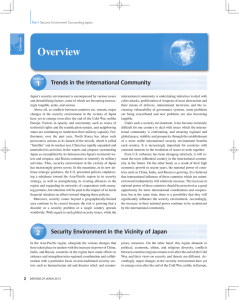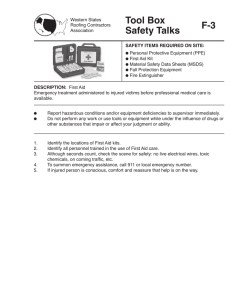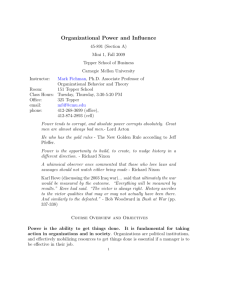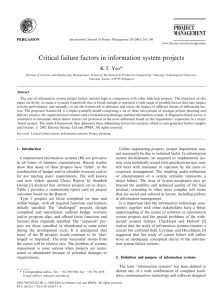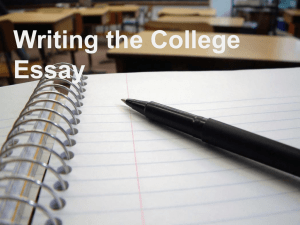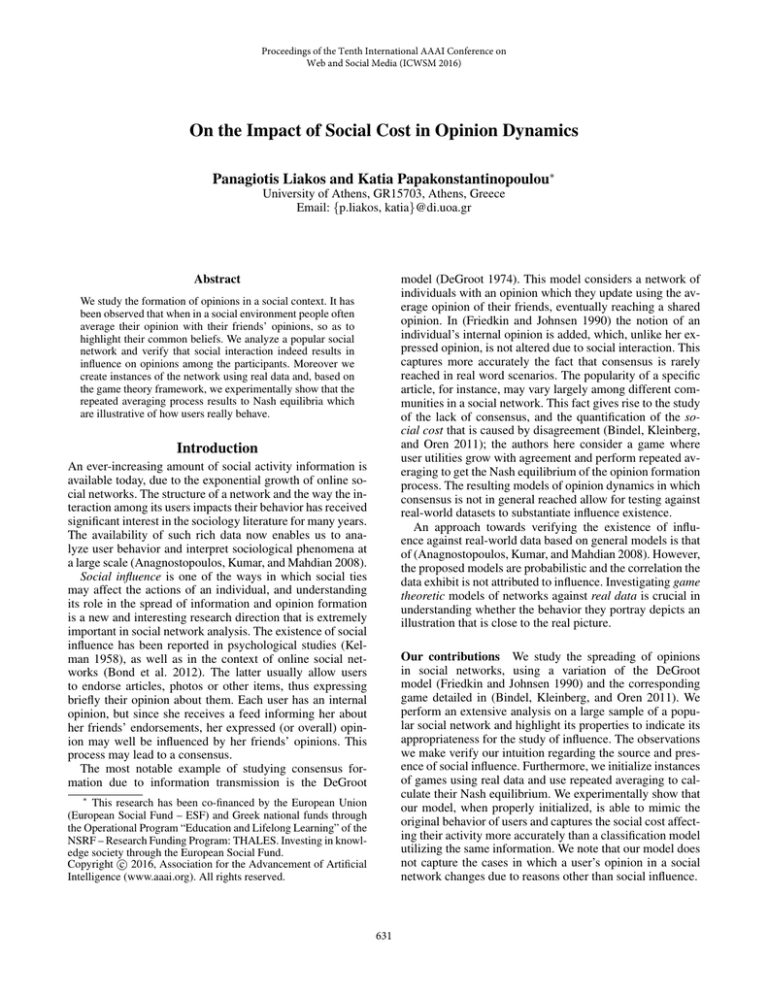
Proceedings of the Tenth International AAAI Conference on
Web and Social Media (ICWSM 2016)
On the Impact of Social Cost in Opinion Dynamics
Panagiotis Liakos and Katia Papakonstantinopoulou∗
University of Athens, GR15703, Athens, Greece
Email: {p.liakos, katia}@di.uoa.gr
model (DeGroot 1974). This model considers a network of
individuals with an opinion which they update using the average opinion of their friends, eventually reaching a shared
opinion. In (Friedkin and Johnsen 1990) the notion of an
individual’s internal opinion is added, which, unlike her expressed opinion, is not altered due to social interaction. This
captures more accurately the fact that consensus is rarely
reached in real word scenarios. The popularity of a specific
article, for instance, may vary largely among different communities in a social network. This fact gives rise to the study
of the lack of consensus, and the quantification of the social cost that is caused by disagreement (Bindel, Kleinberg,
and Oren 2011); the authors here consider a game where
user utilities grow with agreement and perform repeated averaging to get the Nash equilibrium of the opinion formation
process. The resulting models of opinion dynamics in which
consensus is not in general reached allow for testing against
real-world datasets to substantiate influence existence.
An approach towards verifying the existence of influence against real-world data based on general models is that
of (Anagnostopoulos, Kumar, and Mahdian 2008). However,
the proposed models are probabilistic and the correlation the
data exhibit is not attributed to influence. Investigating game
theoretic models of networks against real data is crucial in
understanding whether the behavior they portray depicts an
illustration that is close to the real picture.
Abstract
We study the formation of opinions in a social context. It has
been observed that when in a social environment people often
average their opinion with their friends’ opinions, so as to
highlight their common beliefs. We analyze a popular social
network and verify that social interaction indeed results in
influence on opinions among the participants. Moreover we
create instances of the network using real data and, based on
the game theory framework, we experimentally show that the
repeated averaging process results to Nash equilibria which
are illustrative of how users really behave.
Introduction
An ever-increasing amount of social activity information is
available today, due to the exponential growth of online social networks. The structure of a network and the way the interaction among its users impacts their behavior has received
significant interest in the sociology literature for many years.
The availability of such rich data now enables us to analyze user behavior and interpret sociological phenomena at
a large scale (Anagnostopoulos, Kumar, and Mahdian 2008).
Social influence is one of the ways in which social ties
may affect the actions of an individual, and understanding
its role in the spread of information and opinion formation
is a new and interesting research direction that is extremely
important in social network analysis. The existence of social
influence has been reported in psychological studies (Kelman 1958), as well as in the context of online social networks (Bond et al. 2012). The latter usually allow users
to endorse articles, photos or other items, thus expressing
briefly their opinion about them. Each user has an internal
opinion, but since she receives a feed informing her about
her friends’ endorsements, her expressed (or overall) opinion may well be influenced by her friends’ opinions. This
process may lead to a consensus.
The most notable example of studying consensus formation due to information transmission is the DeGroot
Our contributions We study the spreading of opinions
in social networks, using a variation of the DeGroot
model (Friedkin and Johnsen 1990) and the corresponding
game detailed in (Bindel, Kleinberg, and Oren 2011). We
perform an extensive analysis on a large sample of a popular social network and highlight its properties to indicate its
appropriateness for the study of influence. The observations
we make verify our intuition regarding the source and presence of social influence. Furthermore, we initialize instances
of games using real data and use repeated averaging to calculate their Nash equilibrium. We experimentally show that
our model, when properly initialized, is able to mimic the
original behavior of users and captures the social cost affecting their activity more accurately than a classification model
utilizing the same information. We note that our model does
not capture the cases in which a user’s opinion in a social
network changes due to reasons other than social influence.
∗
This research has been co-financed by the European Union
(European Social Fund – ESF) and Greek national funds through
the Operational Program “Education and Lifelong Learning” of the
NSRF – Research Funding Program: THALES. Investing in knowledge society through the European Social Fund.
c 2016, Association for the Advancement of Artificial
Copyright Intelligence (www.aaai.org). All rights reserved.
631
Model
to which we will refer to as the digg dataset in the following (Hogg and Lerman 2012).
Digg allows users to submit links to news stories and vote
them up (digg). A user is also able to follow other members and track the stories they recently voted for. The digg
dataset consists of the votes of the 3, 553 most popular stories of June 2009, and the directed social graph depicting
the followers of each voter. A total of 3, 018, 196 votes from
139, 409 users and 1, 731, 658 follower edges is available.
The probability distribution of the users’ follows, as well
as the distribution of votes per user are heavy-tailed, indicating that most of the activity can be attributed to a small
number of users. Such heavy-tailed activity patterns have
been tightly connected with many aspects of human behavior (Barabasi 2005).
We focus on a setting in which a group of individuals (also
called users) are members of a social network, and investigate the impact of social influence on their opinions on some
issue. We are concerned with users that perform, within this
network, a certain action for the first time. Consider for example a social network in which a user can endorse articles
and get informed about her friends’ endorsements. We examine whether this information modifies the users’ opinions
on related subjects, e.g., their preferences in articles. We represent the social network as a directed graph. Each node of
this graph corresponds to a user, and there is an edge from
node i to j iff user i gets informed about the actions of j.
In order to identify adjustments in users’ opinions, we
have to observe the system for a certain period of time. We
keep trace of the endorsements of every user (implying their
opinion) and the endorsements of their friends, and compare
their opinions in the initial state of the system to those in
the final state. We assume that if a user endorses an article after some friend of hers has done so, the endorsement
results from influence. Therefore, this comparison indicates
whether some opinion has changed under social influence.
We model the users’ opinions using the notions of (Friedkin and Johnsen 1990) and the game of (Bindel, Kleinberg,
and Oren 2011). Each user i maintains a persistent intrinsic belief si and an overall (or expressed) opinion zi : si remains constant, while zi is updated iteratively, during the
game, through averaging. In what follows, opinion refers to
the overall opinion. We assume that for each user i that endorsed some article prior to all of her friends it is si = 1,
otherwise si = 0. The real number zi represents the probability that i endorses the article. At each time step user i
updates zi to minimize the cost of suppressing her internal
opinion and disagreeing with her friends in the aforementioned game, using the formula:
si + j∈N (i) wij zj
(1)
zi =
1 + j∈N (i) wij
Information propagation and reproductive ratio
Information can travel through many paths in a social network and identifying word-of-mouth hops that form social cascades is a rather infeasible task. To differentiate the
users of digg who endorsed a story due to social influence
from the ones that acted freely, we adopt the heuristic used
in (Cha, Mislove, and Gummadi 2009) and consider an endorsement to have propagated from user i to user j if j endorsed a story after i did, and j followed i before endorsing
the story. If multiple users i satisfy these conditions, we assume that the propagation was caused by all of them. Those
users j that endorsed a story having no users i influencing
them are considered as seeders.
In epidemiological models, the reproductive ratio, denoted R0 , is used to measure the potential for disease spread
in a population (Anderson and May 1991). If R0 > 1, an
infected individual is expected to infect more than one other
individuals and the infection will be able to spread in a population, otherwise the infection will die out. We observe that
in more than 92% of the stories of the digg dataset the total ‘infections’ were less than the number of initial seeders,
indicating that the reproductive ratio is well below 1.
We also examine the distribution of the total cascades
caused by every individual for every story of the dataset,
which appears to be heavy-tailed. This verifies our intuition
about the presence of authoritative users, although the average transmission probability is quite small. However, it is
worth noting that influence varies depending on the story,
and even the users that frequently trigger cascades tend to
be more effective in certain stories than in others. Therefore
a good estimation of bj can only occur when examining it in
the context of a single topic.
where N (i) denotes the set of nodes that i follows and wij
expresses the strength of the influence of j on i. This averaging process terminates when z converges to the unique
Nash equilibrium, which minimizes the social cost, defined
to be the sum of all players’ costs. According to our intuition, the influence of j on i regarding a specific article is
strong if i generally respects j’s opinion and/or j is authoritative on the article under consideration. We therefore define
wij = aij bj , where aij expresses how much j influences i
in general, and bj expresses the expertise of user j on the
topic of the article. The weights wij are used to distinguish
between influential and weak connections, and are real numbers that may be greater than 1, as a user may value the opinion of a friend higher than her intrinsic belief.
Frequent cascade patterns
To further study the complex collective behavior attributed
to the interaction of social network users, we mined the frequent cascade patterns occurring in the digg dataset. In particular, we considered a graph with a node vir for every
{voter i, story r} pair and an edge from vir to vjr , if voters
i and j are friends and i endorsed a story r before j did. Figure 1 illustrates the 20 most frequent cascade patterns met
in such a graph, formed with a sample of 50 stories. We extracted these patterns using G RAMI (Elseidy et al. 2014).
Empirical analysis
We studied the behavior of users in a social network and
the impact of social influence on their actions in its context
by analyzing a sample of Digg1 , a social news aggregator,
1
Digg: http:// digg.com
632
Rank
Pattern
Rank
Pattern
Rank
Pattern
Rank
1
6
11
16
2
7
12
17
3
8
13
18
Pattern
Algorithm 1: Repeated Averaging algorithm
1 initialization of si , aij , and bj for each i, j;
2 foreach i do zi = si ;
3 while not converged do
5
6
7
4
9
14
19
5
10
15
20
foreach i do zinew =
4
8
si + ∀j∈N (i) aij ∗bj ∗zj
1+ ∀j∈N (i) aij ∗bj ;
zi = zinew
for threshold ← 0 to 1 do
calculate recall and precision;
plot the precision-recall curve;
members they follow and are not influenced at all by the
rest of the users, i.e., aij = 1 if user i follows user j, and
0 otherwise.
(ii) An approach that follows our intuition that the influence of j on i increases with the ratio of votes of j that
i followed and builds on the findings reported during our
empirical analysis. We specify aij by how frequently j influences i, using information about the total influence of
j on i to compute the influence on a certain story:
# times i is influenced by j
aij =
(2)
# votes of j
Figure 1: Top-20 cascades that occurred in the digg dataset,
ordered by frequency.
We observe that the spread of information for the stories of our dataset exhibits small chain- and tree-like cascades, as was the case with most of the datasets examined
in (Leskovec, Singh, and Kleinberg 2006). However, splits
are much more infrequent than collisions in our dataset, as
opposed to the datasets of (Leskovec, Singh, and Kleinberg
2006); only the smallest possible split was found among the
20 most frequent patterns (ranked 10th).
Moreover, we quantify bj by how authoritative user j is
for the article under consideration:
# users influenced by j in this story
,
(3)
bj =
# followers of j
thus capturing the expertise of each user per story.
Algorithm 1 outlines our approach2 . We perform repeated
averaging with both configurations until we reach convergence to the unique Nash equilibrium of the corresponding
games. At the state of convergence, the expressed opinions
of the users are given values in [0, 1]. Deciding whether a
value stands for endorsement or not calls for the use of a
threshold. We examine the trade-off between precision and
recall by varying the threshold value to obtain the respective
curves, where precision is the fraction of users predicted as
endorsers that actually voted up, while recall is the fraction
of users that voted up that are predicted to do so.
We also use a Neural Network 3 to train a classification
model thats predict user actions and compare against it. To
this end, we perform stratified 10-fold cross-validation using
the following independent variables, normalized in the range
[−1, 1]: (i) si , (ii) the sum of (2) for every j friend of i, and
(iii) the sum of (3) for every j friend of i.
Experimental evaluation
Having verified our intuition regarding the adoption of an
opinion due to social influence, we apply (1) on real-world
data to examine its fitting performance with respect to our
findings. We conduct experiments on the cascade graphs of
the digg dataset stories to answer:
• How much more improved is the precision of (1) when
distinguishing the crucial aspects of social interaction related to the spread of influence?
• How does (1) perform against a neural network classifier?
Simulation methodology
We perform repeated averaging in our model until the opinions converge to the unique Nash equilibrium. To initialize
our model we apply the following set-up for each story we
examine:
• We consider that every user of digg that endorsed a story
before any of the members she follows did so, has a
strongly positive intrinsic opinion about it. However, we
cannot hypothesize on the intrinsic opinion of users that
voted up a story after at least one of the users they follow
did so, as their behavior can be attributed to numerous
causes. Hence, we consider for user i: si = 1, if i voted a
story before any user she follows, and 0 otherwise.
• Regarding the influential strength of j on i, wij , we consider two variants:
(i) A straight-forward approach where users are equally
authoritative on all stories of digg, i.e., bj = 1 for every j. Additionally, users are equally influenced by all the
Experiments using real-world data
We performed extensive simulations using our methodology on different stories of the digg dataset, and obtained
precision-recall curves for the two configurations of our
model. Furthermore, we obtained the respective curves that
occur with the use of the Neural Network classifier.
2
Our implementation is available here:
https:// bitbucket.org/ network-analysis/ social-cost
3
We employ RapidMiner’s Neural Net operator:
https:// rapidminer.com/
633
1
0.9
0.8
0.8
0.8
0.8
0.7
0.7
0.7
0.7
0.6
0.5
0.4
0.6
0.5
0.4
0.6
0.5
0.4
0.3
0.3
0.3
0.2
0.2
0.2
0.1
Repeated Averaging (wij=1)
Repeated Averaging (wij=aij*bj)
Neural Network
0
0.6 0.65 0.7 0.75 0.8 0.85 0.9 0.95
0.1
1
Repeated Averaging (wij=1)
Repeated Averaging (wij=aij*bj)
Neural Network
0
0.2
0.3
0.4
0.5
0.6
0.7
0.1
0.8
0.9
Precision
1
0.9
Precision
1
0.9
Precision
Precision
1
0.9
0.5
0.4
0.3
0.2
Repeated Averaging (wij=1)
Repeated Averaging (wij=aij*bj)
Neural Network
0
0.3
1
0.6
0.4
0.5
0.6
0.7
0.8
Repeated Averaging (wij=1)
Repeated Averaging (wij=aij*bj)
Neural Network
0.1
0.9
1
0
0
0.2
0.4
0.6
Recall
Recall
Recall
Recall
(a)
(b)
(c)
(d)
0.8
1
Figure 2: Precision/recall curves for the two configurations of our model and a Neural Network classifier.
Figure 2 illustrates the curves for four indicative stories
of our dataset. In particular, we present an extremely popular story with relatively limited cascades (Fig. 2(a), 8, 507
votes and 6, 795 seeders), a popular story with many cascades (Fig. 2(b), 399 votes and 176 seeders), a popular story
with an average number of cascades (Fig. 2(c), 581 votes and
331 seeders), and an unpopular story (Fig. 2(d), 270 votes
and 144 seeders). We observe that the second configuration
of our model captures much more accurately the true activity
of digg in comparison with our simplistic setting. This verifies our belief that the opinions of all users in digg can be
approximated by applying (1), given that the social influence
imposed by users of the network is weighted appropriately.
Moreover, we see in Figure 2 that our model consistently
outperforms the Neural Network classifier, and the improvement becomes more evident as the desired recall increases.
In particular, we observe that for low recall the classifier behaves similarly with our model, as both predict mostly users
with positive intrinsic opinion will vote a story. However, as
we adjust the threshold to acquire higher recall, the tradeoff with precision is worse for the classifier. For instance,
for 90% recall our model achieves on average about 114%
better precision, i.e., 24.46 percentage points higher precision. This is expected, as our model additionally captures
the opinion adjustments during the averaging process.
We note here that the deviation from the original activity of digg for all methods is not surprising. Our hypothesis regarding the internal opinion of its users for each story
is convenient for conducting experiments but may well be
mistaken for quite a lot of them.
defined by the individual cost functions. We presented results comparing this state with the original actions of the
network’s members. Our findings show that a properly initialized instance following our model, converges to a Nash
equilibrium that closely mimics the original social activity
of a real-world dataset. Therefore, we verified that users act
in order to minimize their cost as described in this work.
There are still many interesting open directions left for
future research. We can proceed with estimating the price of
anarchy in such a network. Moreover, we can examine ways
to reduce the social cost of these networks.
References
Anagnostopoulos, A.; Kumar, R.; and Mahdian, M. 2008. Influence and correlation in social networks. In SIGKDD, 7–15.
Anderson, R. M., and May, R. M. 1991. Infectious diseases of
humans. Oxford University Press.
Barabasi, A.-L. 2005. The origin of bursts and heavy tails in human
dynamics. Nature 435(7039):207–211.
Bindel, D.; Kleinberg, J. M.; and Oren, S. 2011. How bad is forming your own opinion? In FOCS, 57–66.
Bond, R. M.; Fariss, C. J.; Jones, J. J.; Kramer, A. D.; Marlow,
C.; Settle, J. E.; and Fowler, J. H. 2012. A 61-million-person
experiment in social influence and political mobilization. Nature
489(7415):295–298.
Cha, M.; Mislove, A.; and Gummadi, K. P. 2009. A measurementdriven analysis of information propagation in the flickr social network. In WWW, 721–730.
DeGroot, M. H. 1974. Reaching a consensus. Journal of the ASA
69(345):118–121.
Elseidy, M.; Abdelhamid, E.; Skiadopoulos, S.; and Kalnis, P.
2014. GRAMI: Frequent Subgraph and Pattern Mining in a Single Large Graph. PVLDB 7(7):517–528.
Friedkin, N. E., and Johnsen, E. C. 1990. Social influence and
opinions. Journal of Mathematical Sociology 15(3-4):193–206.
Hogg, T., and Lerman, K. 2012. Social dynamics of digg. EPJ
Data Science 1(5).
Kelman, H. C. 1958. Compliance, identification, and internalization: Three processes of attitude change. Journal of conflict resolution 51–60.
Leskovec, J.; Singh, A.; and Kleinberg, J. M. 2006. Patterns of
influence in a recommendation network. In PAKDD, 380–389.
Discussion and open directions
In this work we specified the details which allow for a better formalization of the social effects on a variation of the
DeGroot model. To verify our intuition on the causes of social influence, we performed a comprehensive analysis on a
real-life popular social network. In addition to this, we initialized several instances of the dataset and applied repeated
averaging on them to calculate the state where our model
converges. As it is shown in (Bindel, Kleinberg, and Oren
2011), this state is the unique Nash equilibrium of the game
634

